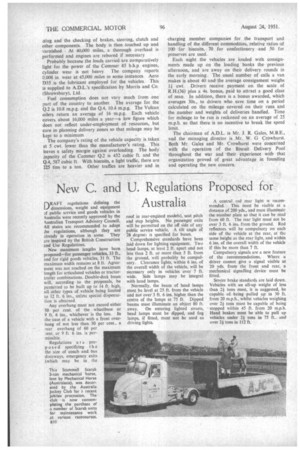New C. and U.
Page 44

If you've noticed an error in this article please click here to report it so we can fix it.
Regulations Proposed for Australia
DRAFT regulations defining the dimensions, weight and equipment af public service and goods vehicles in Australia were recently approved by the Australian Transport Advisory Council. All slates are recommended to adopt the regulations, although they are already in operation in some. They are inspired oy the British Construction and Use Regulations.
New maximum lengths have been proposed—for passenger vehicles, 33 ft., and for rigid goods vehicles, 31 ft. The maximum width remains at 8 ft. Agreement was not reached on the maximum length for articulated vehicles or tractortrailer combinations. Double-deck buses will, according to the proposals, be permitted to be built up to 14 ft. high, all other types of vehicle being limited to 12 ft. 6 ins., unless special dispensation is obtained.
Any overhang must not exceed either 50 per cent, of the wheelbase or 9 ft. 6 ins., whichever is the less. In the case of a vehicle with a front overhang of not less than 30 per cent., a rear overhang of 60 per cent. or 9 ft 6 ins, is permissible.
Regulations a r e proposed specifying the the size of coach and bus doorways, emergency exits (which may be in the
roof in rear-engined models), seat pitch and step heights. No passenger exits will be permitted on the off side of any public service vehicle. A tilt angle of 28 degrees is specified for buses.
Comprehensive standards have been laid down for lighting equipment. Two head lamps, at least 2 ft. apart and not less than 2 ft. or more than 5 ft. from the ground, will probably be compulsory. Clearance lights, within 6 ins, of the overall width of the vehicle, will be necessary only in vehicles over 7 ft. wide. Side lamps may be integral with head lamps.
Normally, the beam of head lamps must be level at 25 ft. from the vehicle and not over 3 ft. 6 ins. higher than the centre of the lamps at 75 ft. Dipped beams must illuminate an object 80 ft. away. On entering lighted streets, head lamps must be dipped, and fog lamps, if fitted, must not be used as driving lights. A central red rear light is recommended. This must be visible at a distance of 200 yds., and must illuminate the number plate so that it can be read from 60 ft. The rear light must not be over 3 ft. 6 ins, from the ground. Red reflectors will be compulsory on each side of the vehicle at the rear, at the same height as the rear light, and within 6 ins, of the overall width of the vehicle if this be more than 7 ft.
Compulsory signals are a new feature of the recommendations. Where a driver cannot give a signal visible at 20 yds. from the front and rear, a mechanical signalling device must be fitted.
Severe brake standards are laid down. Vehicles with an all-up weight of less than 2i tons must, it is suggested, be capable of being pulled up in 30 ft. from 20 m.p.h., whilst vehicles weighing over 2f tons must be capable of being stopped within 45 ft. from 20 m.p.h. Hand brakes must be able to pull up vehicles under 2i tons in 75 ft.. and over 2i tons in 112 ft.




















































































